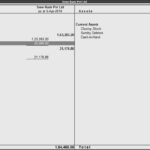Content

Today, we’ll discuss this self-employment tax in further detail, including ways to reduce its overall negative effect on your tax bill. In addition to federal, state, and local income taxes, you also need to pay self-employment taxes on your draw. Similar to the FICA taxes that get withheld from an employee’s paycheck, self-employment taxes consist of money paid for Social Security and Medicare. As a sole proprietor, you pay income tax on all of your profits, regardless of how much you actually draw. Even if you leave your profits in the business, you’re still responsible for paying tax on your earnings.
- Your paper trail can either be in the form of a check or records of an online transfer.
- This way, a disregarded LLC doesn’t have to file income tax returns.
- Practical business and financial insights, lessons, perspectives, and know-how brought right to your inbox.
- LLC has to withhold tax from the employee’s wages for Social Security, Medicare and unemployment insurance, deposit it with the IRS and state agencies.
- Where there are multiple owners, if all of the LLC members participate equally in the operation of the business, you can’t pay one a salary and not the others.
And while making this decision may not be the most exciting part of being your own boss, it is one of the most important decisions you’ll make. The business structure you select influences everything from your tax responsibilities to the paperwork you’re required to file and the risks to your personal assets. A single-member LLC that is a disregarded entity that does not have employees and does not have an excise tax liability does not need an EIN. It should use the name and TIN of the single member owner for federal tax purposes. If an LLC has opted to be treated as an S corporation or C corporation for tax purposes, members aren’t allowed to take owner’s draws. Instead, they’re considered employees and must pay themselves a set salary on the company’s regular payroll with taxes withheld.
Paying Salaries From A Multi-Member LLC
The LLC then files a business return with the IRS stating the amount that each member of the LLC was paid. Instead, you’ll take an owner’s draw from the profits earned by the company. The easiest way to do this is to write yourself a check from the business bank account and deposit it into your personal account.
Keep investigating whether you want to expand your business in the coming year , we have a resource on how SBA loans work that can provide further useful guidance. After you’ve gained a better understanding https://kelleysbookkeeping.com/ of how a single-member LLC operates, read our guide to Form 8832, which explains how to elect a new tax classification. There are many factors to consider when determining the best tax status for your LLC.
What Is an Owner’s Draw?
If your single-member LLC is taxable as a sole proprietorship, you’ll need to pay FICA tax on your business’s net earnings each year. Whether you pay yourself via owner’s draws or keep the money in your company, your FICA tax liability will be the same. The IRS classifies a single-member LLC as a “disregarded entity,” with basically the same rules as a sole proprietorship. That means you won’t have to file separate tax returns for your business and personal income. You only need to “take a salary” if you’re paying yourself through a payroll system.
- A single-member LLC is just as it sounds a limited liability company with one owner .
- If you own a profitable single-member LLC, you’re going to owe payroll taxes.
- Note that a Single-Member LLC is different from a Sole Proprietorship.
- Whether you pay yourself via owner’s draws or keep the money in your company, your FICA tax liability will be the same.
The IRS also narrowly defines passive income as income derived from rental activity. Look at your bookkeeping with an accountant, and figure out how much your business can afford to pay you, beyond the cost of covering personal expenses. How members of a multi-member LLC get paid depends on whether it’s a partnership, Single Member Llc Payroll or a corporation. By default, the IRS treats every multi-member LLC as a partnership. For example, if you have a single-member LLC that is not generating much income, it may not be necessary to draw a salary. If you have a multi-member LLC that is profitable, you have to decide how to divide the profits among members.
Is There Any LLC Income That Is Exempt from Self-Employment Tax?
Performance information may have changed since the time of publication. You have several options to pay yourself from an LLC, including salary, wages, profit distributions and independent contractor pay. You can also abstain from taking any pay if you want to keep the money in the business or the business isn’t generating enough revenue to pay you. In this arrangement, you—and other owners who actively work in the business—are employees/owners, and you receive paychecks just as you would as an employee of someone else’s business. If your LLC is taxed as a partnership, normal tax rules apply to the business. This means that all taxes flow through to the members, and the LLC’s income is taxed on each member’s tax return.

To learn how to withhold these, check out our guide on how to calculate and pay estimated tax. Because of this requirement, any distributions taken from an S corporation must be proportional to the shareholder’s stock ownership percentage. The amount that an owner draws from an LLC is at the discretion of the owner. The distribution of funds does not create a taxable event since the owner is taxed on the profit of the business, not how much money is transferred to the owner.